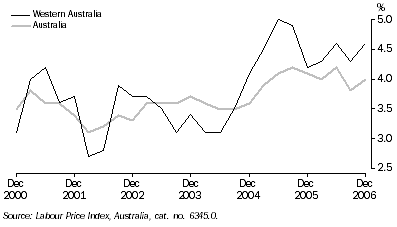 PRICES
PRICES
CONSUMER PRICE INDEX
Inflation eased in Perth over the last two quarters, with growth in Perth's consumer price index (CPI) falling to 0.4% in the December quarter 2006, down from 1.8% and 1.1% in the two preceding periods respectively. Nationally, prices fell by 0.1% during the December quarter, the first fall since the March quarter 1999 (down 0.1%). The most significant falls nationally were automotive fuel (down 12.4%), fruit (down 5.2%), pharmaceuticals (down 5.0%) and audio, visual and computing equipment (down 2.7%).
The higher CPI growth in Perth was mainly driven by higher than average prices in recreation (up 2.8%) and housing (up 0.7%). Within recreation, domestic holiday travel and accommodation rose by 9.3% and overseas holiday travel and accommodation was up 5.0%, the result of seasonal increases in accommodation tariffs and airfares. Housing costs also continued to fuel inflation in Perth, with the price of purchasing a house rising by 0.8% during the quarter. Closely related to housing, the price of furniture and furnishings rose by 2.7%.
Similar to the price falls nationally, Perth's CPI inflation was curtailed by falling prices for automotive fuel (down 11.4%), pharmaceuticals (down 3.5%), audio, visual and computing equipment (down 3.2%), toiletries and personal care products (down 2.9%) and fruit (down 1.9%).
CONSUMER PRICE INDEX (ALL GROUPS), Change from same quarter previous year

Through the year to December quarter 2006, Perth's CPI rose by 4.4% compared to the national rise of 3.3%. All capital cities recorded price increases during the year, ranging from 2.5% in Hobart to 5.0% in Darwin. The higher result for Darwin was largely due to a 9.5% rise in housing (nearly triple the national average of 3.2%), while Perth also recorded a significant rise in housing of 7.7%. Despite prices continuing to rise across the nation, the rate of growth has eased markedly from 3.9% in the September quarter 2006 to 3.3% in the current period. This slowing of inflation follows a tightening bias by the Reserve Bank of Australia, with increases of official interest rates by 25 basis points in May (5.75%), August (6.00%) and November (6.25%) 2006.
WAGE PRICE INDEX
Wages grew by 1.1% in Western Australia in the December quarter 2006, according to the wage price index of total hourly rates of pay excluding bonuses. Over the year, Western Australia's wages rose by 4.6% through the year to December quarter 2006, higher than the rise of 4.3% through the year to September 2006. Nationally, the wage price index grew by 4.0% through the year to December quarter 2006.
WAGE PRICE INDEX, Change from same quarter previous year

Western Australian industries recording large increases in wages through the year to December 2006 included mining (up 7.0%), property and business services (up 6.0%) and construction (up 5.5%), while professionals (up 5.6%) and managers and administrators (up 5.3%) showed significant increases from an occupation perspective.
 Print Page
Print Page
 Print All
Print All